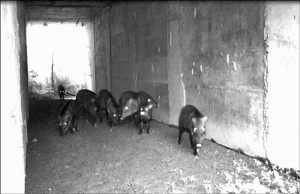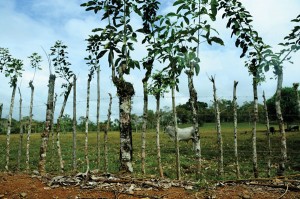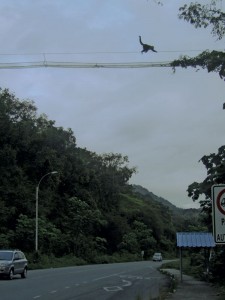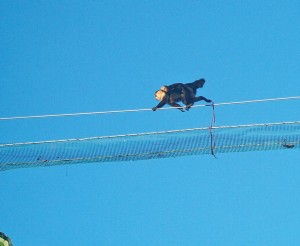How Do You Help a Wild Pig Cross the Road?
By Jack Ewing

I once saw a menu from a fictitious restaurant called the Road Kill Cafe. “You Kill it; we grill it.” It offered selections such as flat cat, smear of deer, awesome opossum, chunk of skunk, and swirl squirrel. The daily special was called “The Mess. If you can guess what it is, you eat it for free.” The chef’s name was “Squash em Jack.” I always thought that menu was hilarious, but later in my life, I realized that road kill is a serious problem that can have a major impact on wildlife populations. I think the experience that really brought the problem to my attention was the day an employee brought a dead jaguarundi for me to see. It had dashed out in front of his car so quickly that he didn’t have a chance to brake. That incident made me realize that steps needed to be taken to minimize road kill and maintain connectivity between forests on both sides of our roads and highways. We live in biological corridor where biodiversity has been increasing since the mid 1980s, and where, until recently, the roads were so bad that cars couldn’t go fast enough to kill any but the slowest animals. The construction of new highways and the improvement of old ones has changed all of that.
What is today called the Path of the Tapir Biological Corridor is bounded by the Savegre River to the north, the Tinamastes Ridge to the east, the Grande de Térraba River to the South, and the Pacific Ocean to the west. As late as the 1920s the area was completely wild land covered by primary rainforest and inhabited by a multitude of fauna. The first settlers to move into the area cleared the land with axes and machetes. Then they used it to grow crops and raise cattle. By the 1950s people were using chain saws and bulldozers to fell the trees and clear the land. By the early 1970s when I came to Hacienda Barú most of the usable land had already been cleared, primarily for cattle pasture. Beef export for the fast food industry in North America was a big business in Costa Rica, and raising cattle was profitable. In this region Hacienda Barú was one of the few places that hadn’t been entirely deforested. Of its 330 hectares (815 acres,) almost half had been cleared for cattle ranching and rice farming. There was a mangrove estuary and two small patches of forest in the lowlands and about 170 hectares (420 acres) of primary rainforest in the highlands. The rest was mostly devoid of trees. There were large areas of open pasture separating the isolated forest fragments.

In the past when it had been necessary to build a fence, the first step was to cut down some trees. These were then split into posts using metallic wedges of different sizes which were driven into the trunk with a sledge. The problem was that all of the good trees, the ones that were resistant to rot, had already been cut down, and posts made from those that remained would rot in less than five years. For that reason I decided to use living posts. That way, instead of cutting down trees, we planted them, and when they were well rooted and thick enough, we nailed the wire to them. In the tropics certain species of trees can be grown from a cutting. In other words you can cut a branch off of the tree, stand it up in the shade until roots sprout from the bottom end, dig a shallow hole, stick it in the ground, and it will grow into a tree. In the late 1970s we started using this type of posts every time we had to build a fence. The types of trees that grow from cuttings are almost always fast growing species. In the tropics that means that they can easily reach three to four meters in height in a couple of years.
When the trees reached about twice the height of a pro basketball player, the monkeys started using them to move between forest fragments. The first time I saw white-faced capuchin monkeys moving down a line of trees was a little over two years after the trees had been planted. At that time there was a troop of monkeys in the mangrove estuary, located in the lowlands near the mouth of the Barú River, and several troops in the highland rainforest. Occasionally monkeys moved from one to the other. Prior to the living fences this meant crossing 400 meters of open pasture. By planting the living posts we had unwittingly provided a means for the monkeys to move from one patch of forest to another without risking encounters with dogs, coyotes and other predators.
Even though these living fence lines were only one tree wide, they were functioning as wildlife corridors in their simplest form. When people ask me how wide a biological corridor has to be, I always say that it has to be at least one tree wide, but anything wider than that is better. One line of trees is better than 400 meters of open pasture, as I’m sure the monkey that encountered the dog will agree, or maybe in this case, the dog that encountered the monkey. A corridor 100 meters wide is better than that, and, of course, one a kilometer or five kilometers wide is better yet. There were two areas in the lowlands of Hacienda Barú where poor soil conditions prevented the establishment of good pasture grasses. Having seen how the monkeys would use a single line of trees as a passage way, I decided to let these marginal strips of land regenerate into secondary forest. There were two of them, and each was about 100 meters wide. One connected the mangrove to the primary forest near our house, which we called “la casona”, where today there is the ASANA office and the Hacienda Barú Biological Research Center. The other corridor was located near the present day Hacienda Barú Lodge.

As the secondary forest that comprised these two corridors matured more and more animals started using them. At that time the road was narrow, rough, and there wasn’t much traffic. Nevertheless, the arboreal animals preferred not to come to the ground to cross it. The lodge corridor had a place where two large tree branches, one from each side of the road, arched out above the road and overlapped, thus providing a natural bridge where the animals could cross. The casona corridor didn’t have any overlapping branches, but we had suspended a black plastic water pipe from one treetop to another, across the gravel road, in order to carry water to our house, la casona. One night, while photographing bats, a biologist noticed something walking across the top of the water pipe. Unable to identify the moving creature in the darkness, he snapped a photograph. Much to our delight, the developed print revealed the animal to be an olingo (Bassaricyon gabbi), the first one ever identified on the Hacienda Barú reserve. After this incident, we began to closely watch the suspended pipe and soon discovered that many other animals, such as monkeys, sloths, anteaters, opossums and coatis, were using it as a means to safely cross the road. I’m sure that all of these animals would have preferred to cross the road on tree branches, but since that option didn’t exist, they quickly adapted to the artificial structure.
Bridges for wildlife have been built in several places. At one time there were some animal bridges across the highway to the south of Dominical in the Playa Hermosa area. These were done by ICE, the electrical institute. They were made of netting and were very flexible. I don’t know how effective they were, as I don’t know of anyone who has ever seen an animal cross the road on one of them. In Manuel Antonio a local conservation group has stretched thick ropes across the roads so the squirrel monkeys can cross. These have been very effective. However the roads at Manuel Antonio are narrow and the bridges are no longer than 20 meters.
When the Ministry of Transport (MOPT) started doing the studies for the new highway to the south of Quepos, we at Hacienda Barú began negotiating for measures that would maintain connectivity and minimize the amount of animals killed on the road. Due in part to our insistence, several conditions were written into the environmental impact statement (EIS) for the new highway. The EIS stated that bridges and tunnels to facilitate animal crossings would be built on the three kilometers where the highway traversed Hacienda Barú National Wildlife Refuge. In the end there were a total of 20 square tunnels, 9 round tunnels, and four bridges. Two of the bridges were built at the lodge corridor and the other two at the casona corridor. The tunnels were placed in locations where animals had always crossed the road.
Experiences in other parts of the world have shown that animals will use a square or rectangular tunnel, but shy away from a round one. At Hacienda Barú a few of the animals started using the tunnels right away, and with time more and more animals learned to use them. This was evident from the tracks at the approaches to the tunnels. It was also evident that as the usage of the tunnels increased, the amount of road kill diminished. In June of 2013 we placed a trail camera at the mouth of one of the square tunnels. In only five days the camera took 33 videos of collared peccary, five of pacas, and two of coatis. The camera is still in place and recording the animals that pass through the tunnel. Some of the round tunnels have animal tracks as well. Soon we will move one of the cameras to one of these round tunnels to record the wildlife that crosses through them. We regularly post videos from our trail cameras on the Hacienda Baru facebook page for those who care to see them.

The animal bridge design consists of two cables with space bars to keep them separated. Then the whole bridge is wrapped in green netting, the kind used in plant nurseries. The bridges are about 40 centimeters wide, a natural color and semi-rigid like a tree branch. Primate specialist Florence Vallet suggested putting another cable about 30 centimeters above the bridge so that animals with prehensile tails could grab onto it. The highway department agreed to this modification, and it was incorporated into the bridge design. The main problem with the bridges was their length, the longest being 63 meters and the shortest 26 meters. We knew that monkeys, opossums, raccoons, kinkajous, olingos and anteaters would use a bridge, but we weren’t sure they would use one that long. A year went by and nobody had reported seeing an animal on a bridge. The monkeys were still crossing the road on foot, and at least two had been hit by cars and killed. A year and seven months after the completion of bridges an employee of Hacienda Barú watched and photographed a troop of monkeys crossing the highway on the shortest bridge at the casona corridor. Curiously they used the single cable above the main bridge. Later they were seen on the bridge itself. Soon thereafter they started using the other bridge on the same corridor. This one is 43 meters long. Since that time many sightings have been reported and many photographs have been taken. Tourists became very emotional at seeing them. One ecological tourist commented how nice it was to be in a country where the Highway Department would care enough to provide animal crossings. “This is a wonderful example for the rest of the world,” she said.
During a two month period the monkeys used both of the bridges at the casona corridor almost daily. We think there were two different troops of monkeys using the bridges. We do know that there are seven troops of monkeys on the lowlands of Hacienda Barú that potentially have access to the bridges. We wondered how long it would take the other troops to learn. Occasionally a monkey will move from one troop to another. This might be, for example, a young male that is expelled from his troop by a dominant male, and is later accepted into another troop. If a monkey from a troop that knows about crossing the bridges ends up in another troop, it is probable that he/she will teach the monkeys of the new troop to cross the bridges. Only time would tell.
About two months after the monkeys started using the bridges the Costa Rican Electrical Institute (ICE) decided to move the electrical lines and run them along the edge of the new highway. With total disregard for the environmental impact statement of the highway, for the biological corridor, and for everything that had been accomplished, they destroyed the monkey’s passage way. One day the monkeys were crossing the bridges, and the next day they perched in the trees on one side of the road and stared at the electrical lines where the bridge ended on the other side of the road. It took about a year, but we managed to solve the problem. ICE agreed to let us plant some short trees under the lines, so the monkeys could still cross. Also one of the trees at the end of the shortest bridge sprouted a branch that within a year had spanned the gap. The monkeys started using them again. Hopefully ICE won’t get their signals crossed and destroy the crossing a second time.
Wildlife observation and bird watching attract many tourists to this region, and preserving our wildlife is essential if we hope to continue to cater to ecological tourism.
We have learned a great deal from these experiences with bridges and tunnels and have been sharing the lessons learned with officials from MOPT and environmental ministry (MINAE.) Our hope is that others will take this knowledge, improve on it, and put it to work in other parts of the country.

